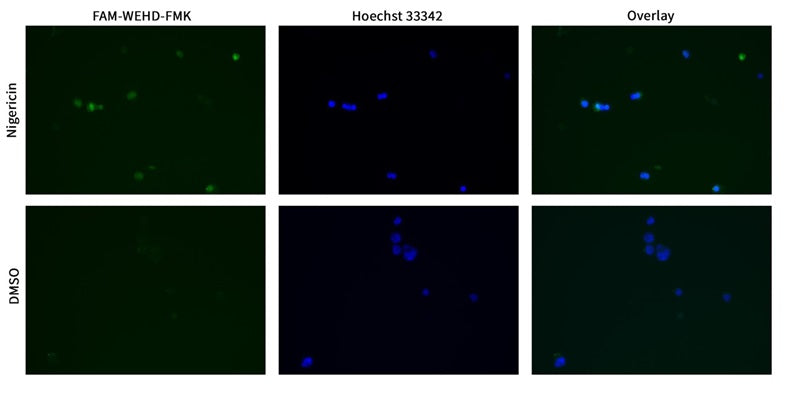- Prepare samples and controls
- Dilute 10X Apoptosis Wash Buffer 1:10 with diH20.
- Reconstitute FLICA with 50 μL DMSO.
- Dilute FLICA 1:5 by adding 200 μL PBS.
- Add diluted FLICA to each sample at 1:30 (e.g., add 10 μL to 290 μL of cultured cells).
- Incubate approximately 1 hour.
- Remove media and wash cells 3 times: add 1X Apoptosis Wash Buffer and spin cells.
- If desired, label with additional stains, such as Hoechst, Propidium Iodide, 7-AAD, or an antibody.
- If desired, fix cells.
- Analyze with a fluorescence microscope, fluorescence plate reader, or flow cytometer. FAM-FLICA excites at 492 nm and emits at 520 nm.
If working with adherent cells, please see the manual for additional protocols.
Kit 9162: 100 Tests
Product Specific References
| PMID | Publication |
| 39369873 | Miranda E Castor, RG, et al. 2024. Glibenclamide reverses cardiac damage and NLRP3 inflammasome activation associated with a high refined sugar diet. European Journal of Pharmacology, 177035. |
| 37121693 | Zhang, Y., et al. 2023. Blocking CXC Motif Chemokine Ligand 2 Ameliorates Diabetic Peripheral Neuropathy via Inhibiting Apoptosis and NLRP3 Inflammasome Activation. Biological & pharmaceutical bulletin, 672-683. |
Question: What is the difference between YVAD and WEHD and when is it an advantage using one or the other?
Answer: Our new product offering FAM-WEHD-FMK is similar to our existing FAM-YVAD-FMK Assay. Both of these peptide sequences are known to target caspase 1,4, and 5. The WEHD sequence is thought to be a “better” caspase-1 target, as the kcat/kM rate is higher for WEHD vs YVAD (meaning faster conversion of substrate product by the enzyme). However, please note that if our understanding of how FLICA works is correct, the FLICA probe never actually binds to the enzyme via the YVAD or WEHD sequence, but rather the FMK moiety, then perhaps these faster binding kinetics are something of a moot point. In practice the performance characteristics of the two product are very similar. In our lab they were shown to be virtually indistinguishable. Nevertheless, we decided to carry both options so that customers can select their preferred targeting sequence based on their individual needs and experience.
Question: Customer is not seeing a difference between control and induced cells(induction with LPS+ATP). Can we help with optimization? Parameters: macrophages induced from THP-1 cells, using 50 ng/ml PMA for 48 hr Cells in 12 well plates at 3×10^5 cells/well Three groups: experimental with HIV, Positive Control and Untreated. Given fresh media 24 hrs then added 1 ug/ml LPS for 24 hr then 5 mM ATP for 2 hr
Answer: In our lab, we actually saw a greater response in the THP-1 monocytes (not PMA-primed), we had the greatest response with LPS exposure at 100 ng/mL + 5 mM ATP for 24 hours. In our THP I monocyte studies we found induction levels ranging from 10-30% (average was 26.2%) in 24 hour (LPS/ATP exposure) samples compared to 3-8% in negative controls. When working with THP-1 cells primed with PMA to become macrophage-like, in general we were able to achieve better results with lower LPS concentrations and exposure periods than with the THP-1 monocytes. For instance, exposure to 10ng/mL LPS for 2 hours without any supplemental ATP was sufficient to produce the desired effect. I am a bit concerned that the customer’s use of 1 ug/mL LPS for 24 hours may be too high concentration/exposure period and the susceptible cells are moving through pyroptosis, lysing, and are lost from the positive control sample well prior to even receiving the FAM-YVAD-FMK stain. If this is the case, they are missing the period when more of the positive control cells would be stain positive with FAM-FLICA. I would encourage them to experiment with lower LPS concentrations and exposure periods and see if their results are improved. It is also important to note caspase-1 is rapidly secreted by macrophages after its activation by the inflammasome pathway. Therefore, it turns out macrophages might not be the best cell model for use with this product. We have also been working with nigericin, as an alternate inducing agent.
Question: The component FAM-YVAD-FMK Part#665 vial in the kit is empty. Please help me to solve this problem.
Answer: All of our FLICA products, including FAM-YVAD-FMK, are lyophilized as part of the manufacturing process. The vials contain such a small amount of material (µg quantities) that the green FAM-FLICA reagents are nearly invisible in the amber vials. It may be visible as a slight iridescent sheen on the sides of the vial. Per the instructions in our manual, the FLICA vials are reconstituted in DMSO and diluted into PBS and subsequently diluted into cell culture media for staining cells. In order to check that the FLICA vial contains the proper lyophilized reagent, please check the appearance of the DMSO-reconstituted FLICA reagent. It should be orange in appearance and once diluted 1:5 in PBS, the FAM-FLICA reagent should be yellow in appearance.



